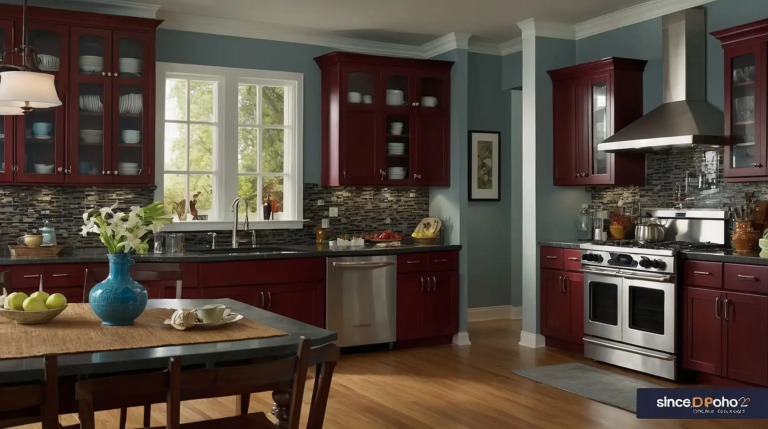27 Clever Office Living Room Combo Ideas That Maximize Your Space
As remote work becomes increasingly common, many of us face the challenge of carving out productive workspace within our homes.
The living room often presents the perfect opportunity to create a dual-purpose area that serves both professional and relaxation needs.
With thoughtful planning, you can design a space that seamlessly transitions between focused work and comfortable downtime.
The key lies in selecting versatile furniture, establishing visual boundaries, and incorporating storage solutions that maintain harmony between these distinct functions.
Discover these innovative office-living room combinations that prove you don’t need to sacrifice style, comfort, or productivity when creating a multifunctional space in your home.
1: Behind-the-Sofa Desk Setup

Position a narrow console table or desk directly behind your sofa to create a distinct workspace without consuming additional floor space.
This clever arrangement utilizes the often-wasted area behind seating. Add task lighting and a comfortable chair that can tuck completely under the desk when not in use.
The setup allows you to face away from the living area while working, minimizing distractions.
When your workday ends, simply push in your chair to return the space to its living room function.
2: Corner Workstation Nook
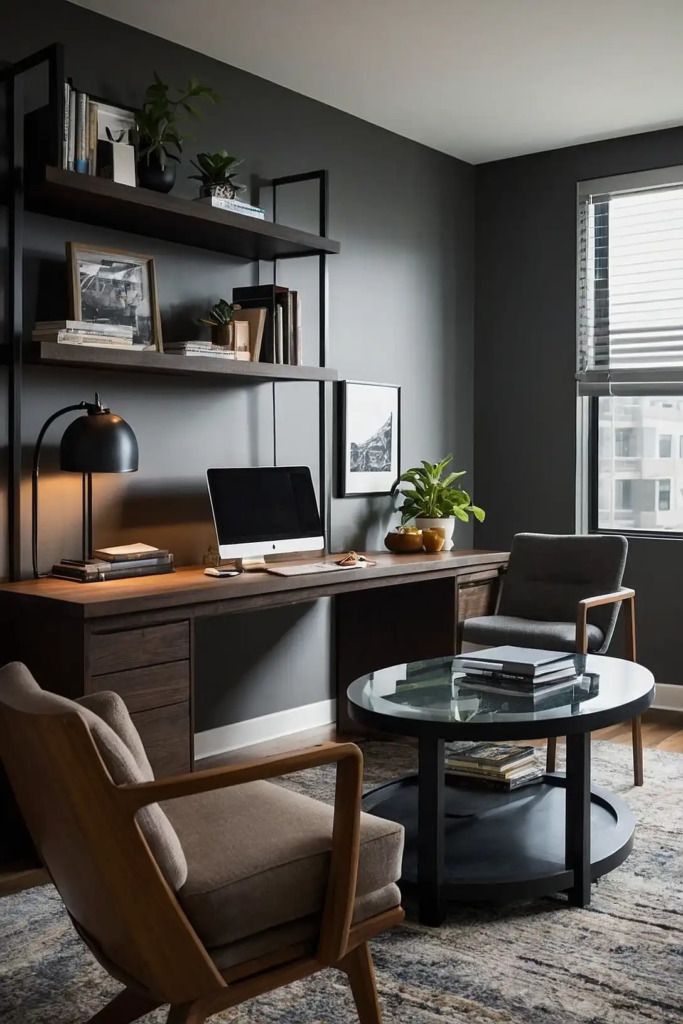
Transform an underutilized living room corner into a dedicated office area with an L-shaped or corner desk.
This arrangement maximizes efficiency in the typically wasted corner space. Install floating shelves above the desk to add vertical storage without consuming floor area.
The corner location naturally creates a psychological boundary between work and relaxation zones.
Choose a desk and shelving in finishes that complement your living room furniture for visual cohesion.
3: Convertible Secretary Desk

Incorporate a traditional secretary desk that opens for work and closes to conceal office clutter afterward.
These classic pieces feature fold-down writing surfaces and built-in storage compartments.
The closed desk presents an attractive furniture piece that blends with your living room aesthetic.
Modern versions come in various styles from mid-century to contemporary, fitting diverse design schemes.
This solution works perfectly for small spaces where visible office equipment would disrupt your living room’s relaxing atmosphere.
4: Room-Dividing Bookshelf
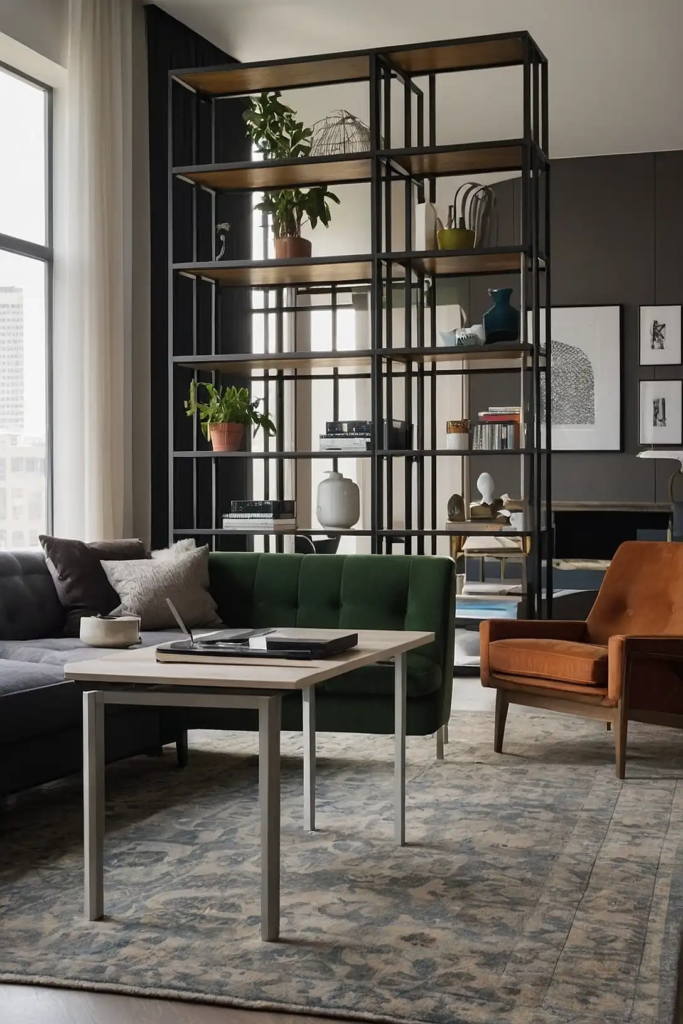
Position a substantial bookcase perpendicular to your wall, creating a partial room divider that defines separate zones.
The open shelving maintains airflow and light while establishing distinct areas. The physical barrier helps mentally separate work from relaxation activities.
Use the living room-facing shelves for decorative items and books, while work-facing shelves hold office supplies.
Select a bookcase with a finished back if it will be visible from both sides of your room.
5: Floating Desk with Hidden Storage
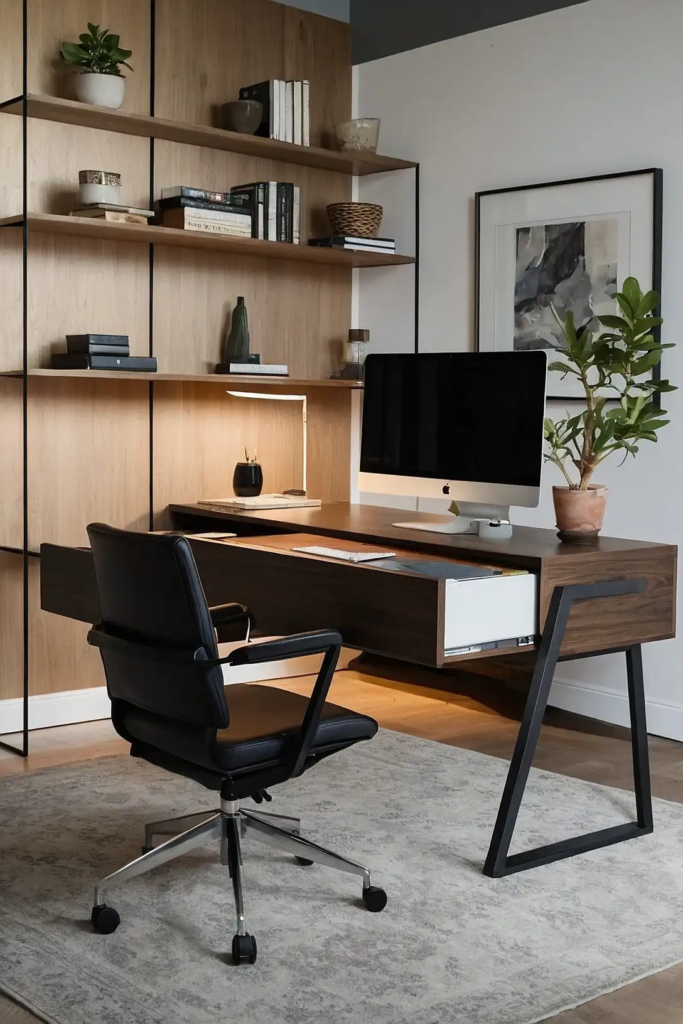
Mount a wall-hung desk that can be closed and transformed into decorative wall art or a shallow cabinet.
These ingenious units fold up when not in use, completely concealing your workspace. Many designs include interior storage for laptops, documents, and small office supplies.
When closed, these units project only inches from your wall, maintaining your living room’s open feeling.
Choose designs with exterior finishes that complement your living room decor or feature decorative elements.
6: Window-Adjacent Workspace

Position your desk perpendicular to a window, creating a workspace that capitalizes on natural light without blocking the view.
This orientation prevents screen glare while providing pleasant outdoor views. The perpendicular arrangement allows the desk to serve as a subtle room divider.
Select a desk with minimalist design that won’t visually obstruct your window’s light when viewed from the living area.
Add adjustable window coverings to control light levels during different work tasks and times of day.
7: Built-In Cabinet Workstation

Convert an existing living room cabinet or entertainment center into a concealed office space.
Install a pull-out work surface and organize office supplies within the cabinet’s interior. Add power outlets inside the cabinet for convenient device charging and operation.
When closed, the area maintains its living room appearance without visible office elements.
This solution works particularly well in traditional living rooms where modern office equipment would disrupt the aesthetic.
8: Dual-Purpose Console Table

Select a console table with appropriate height and depth for laptop work that normally functions as living room furniture.
Position behind your sofa or along a wall where it serves decorative purposes. Choose models with drawers to discretely store office supplies when not in use.
The table serves multiple functions—displaying decorative items, providing sofa table surfaces, and offering workspace.
This approach requires minimal investment while maximizing existing furniture versatility.
9: Armoire Office Station
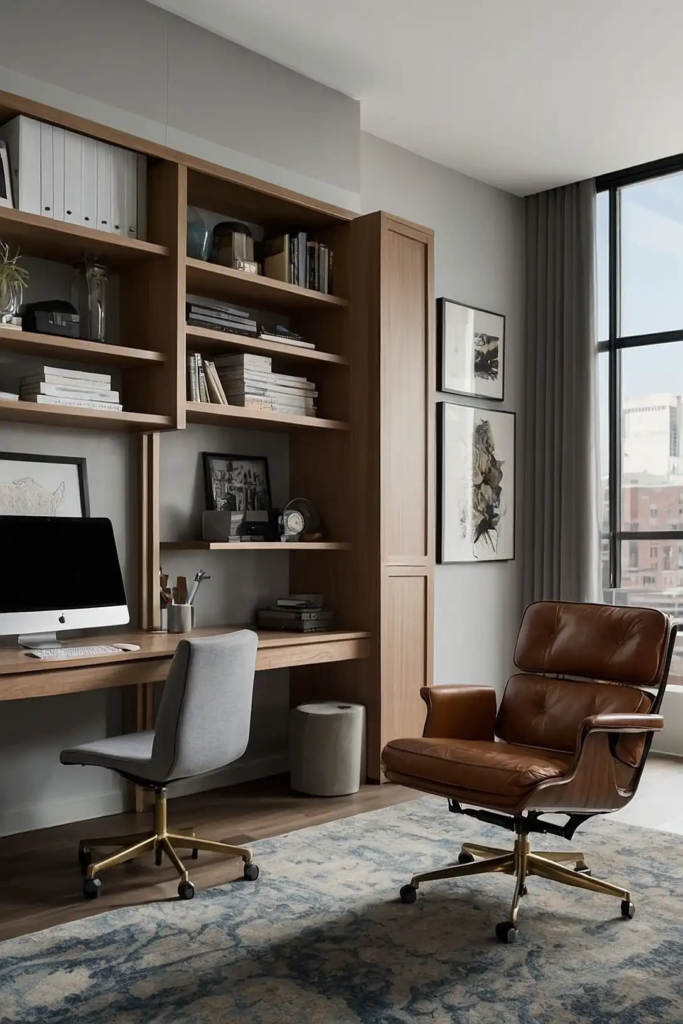
Repurpose a traditional armoire or entertainment cabinet as a dedicated office zone that closes completely after use.
These substantial pieces provide generous storage and a proper work surface. Install adjustable shelving and organize with containers to maximize interior efficiency.
The closed cabinet maintains your living room’s cohesive appearance during relaxation hours.
Select an armoire style that complements your living room furniture for seamless integration.
10: Alcove Transformation

Convert a living room alcove or recessed area into a dedicated workspace with built-in or freestanding desk components.
These architectural features naturally define separate functional zones. Add floating shelves above for storage without consuming floor space.
Install sconces or under-cabinet lighting to ensure adequate task illumination without requiring floor space.
Consider adding sliding panels or curtains to conceal the workspace after hours when desired.
11: Multi-Level Work Surface
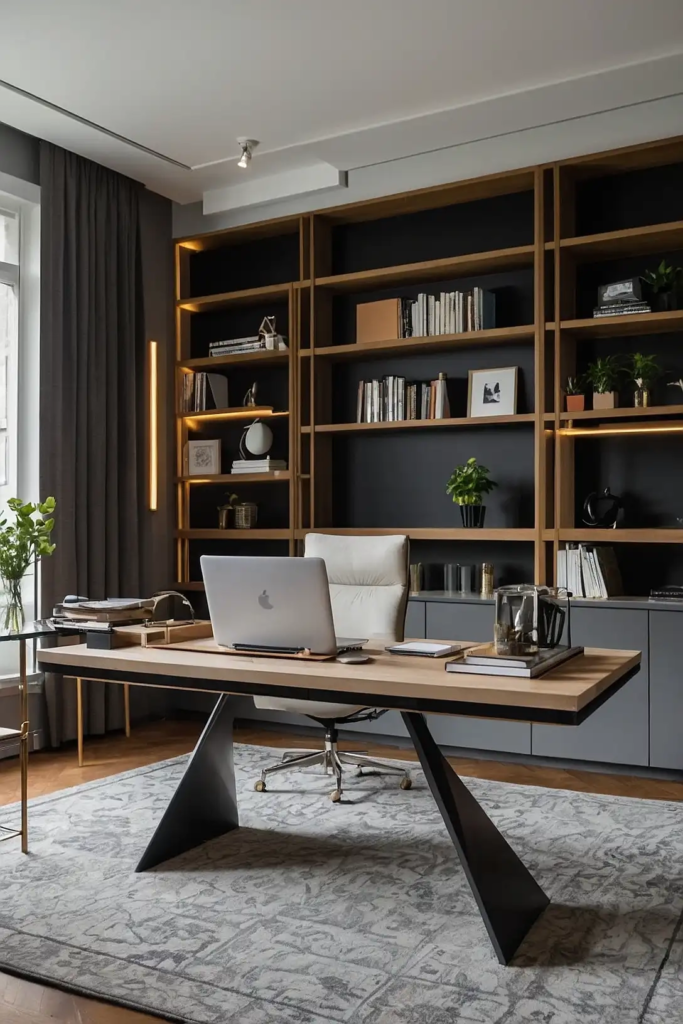
Incorporate a desk with variable heights that accommodates both focused work and casual activities.
These innovative pieces feature sections that raise and lower for different functions.
The higher surfaces work perfectly for standing work sessions or laptop use. Lower sections can serve as coffee tables or casual surfaces when work ends.
This chameleon-like furniture maintains visual harmony while adapting to changing daily needs.
12: Living Room Island Workspace

Position a desk-height table in an open-concept living area, functioning similar to a kitchen island.
This central placement allows productivity while maintaining connection with the surrounding space.
Select a design with attractive finishes on all sides since it will be visible from multiple angles. The accessible-from-all-sides design facilitates collaboration when needed.
Choose a style that complements your living room aesthetic while providing practical work surfaces.
13: Desk Behind Accent Chairs

Place your workspace behind a pair of living room accent chairs, creating natural division between functions.
This arrangement establishes a visual barrier while maintaining an open floor plan. Position chairs to face away from your desk, minimizing visual distraction during work hours.
The chairs serve as an informal boundary, psychologically separating work and relaxation zones.
This solution works particularly well in larger living rooms with adequate depth for multiple furniture groupings.
14: Modular Furniture System
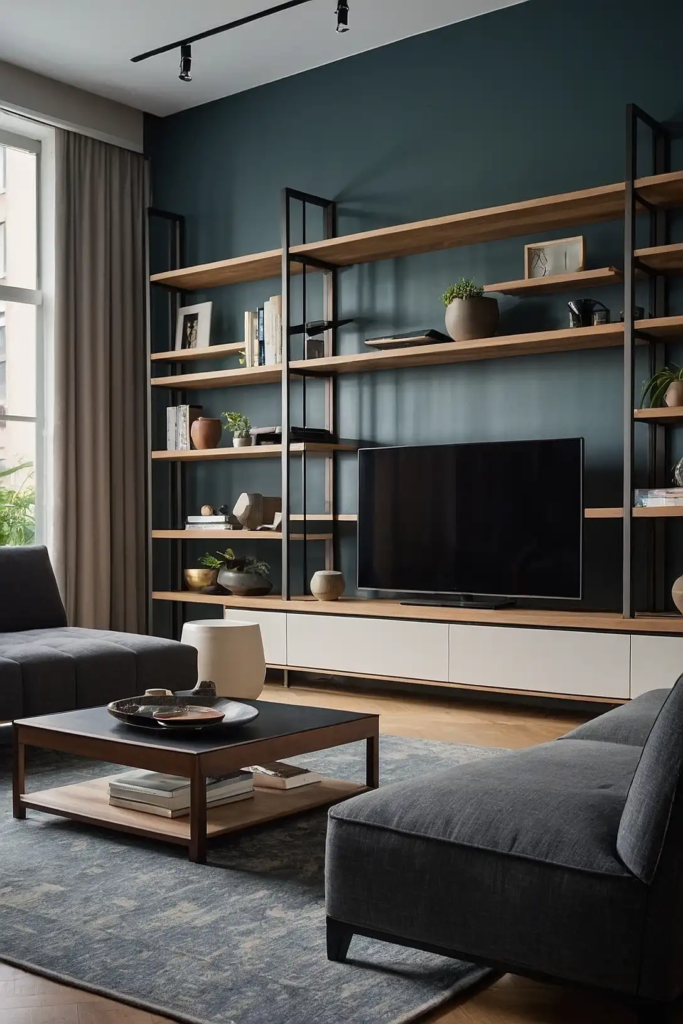
Invest in adaptable furniture pieces designed to transform between office and living functions.
These innovative systems feature components that reconfigure for different needs throughout the day.
Look for pieces with adjustable heights, mobile components, and nestling capabilities.
The flexibility allows your space to evolve from productivity center to entertainment area within moments.
Choose systems with consistent design language that maintains visual cohesion across all configurations.
15: Bay Window Office Space

Transform a bay window area into a naturally illuminated workspace that capitalizes on architectural features.
The recessed space creates a natural divider from the main living area. Add comfortable cushions that serve both as desk seating and window reading nooks.
Install a custom-cut desk surface that follows the window’s contours for an integrated appearance.
The abundant natural light creates an energizing workspace while the unique position minimizes intrusion on living functions.
16: Nested Desk Arrangement
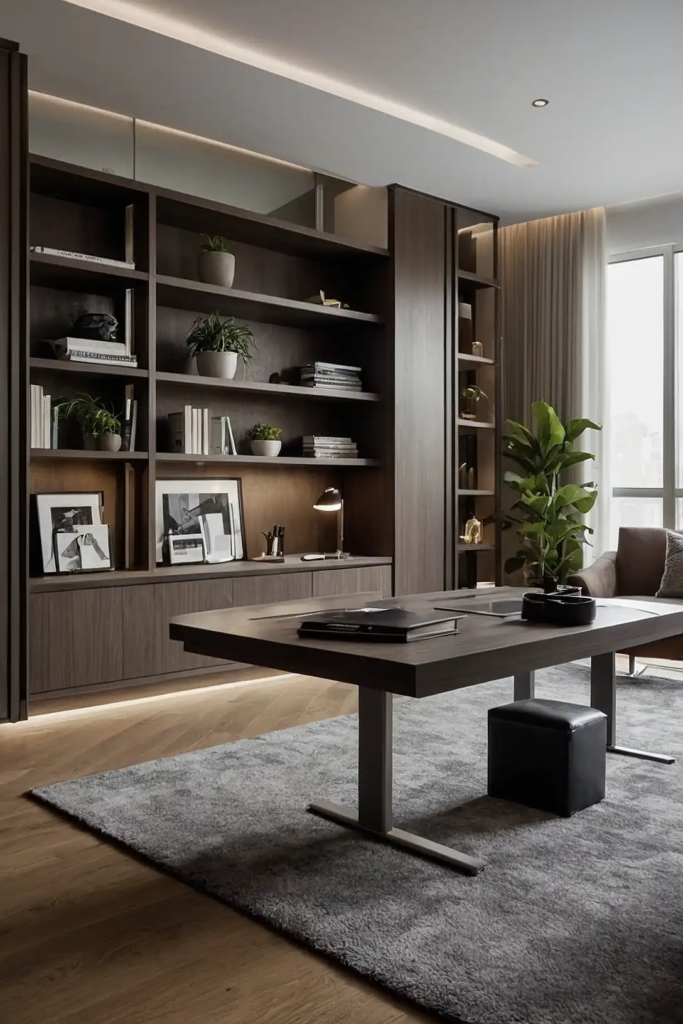
Select a desk that partially tucks beneath a console table to create a tiered workspace with minimal footprint.
This nested arrangement maximizes vertical space while minimizing floor area consumption.
The lower desk pulls out when needed and retreats when not in use.
Choose designs with complementary finishes that read as intentional furniture groupings rather than utilitarian office pieces.
This configuration works particularly well along walls where depth is limited but vertical space is available.
17: Coffee Table with Lifting Surface

Incorporate a coffee table with a raising section that transforms into a proper-height work surface.
These dual-function pieces look completely like living room furniture until converted. Storage compartments beneath hold office supplies out of sight when not needed.
The lifting mechanism provides ergonomic height for laptop work while maintaining coffee table functionality.
This solution proves ideal for spaces too small for separate work surfaces or for occasional home office needs.
18: Discrete Floating Shelves Workstation
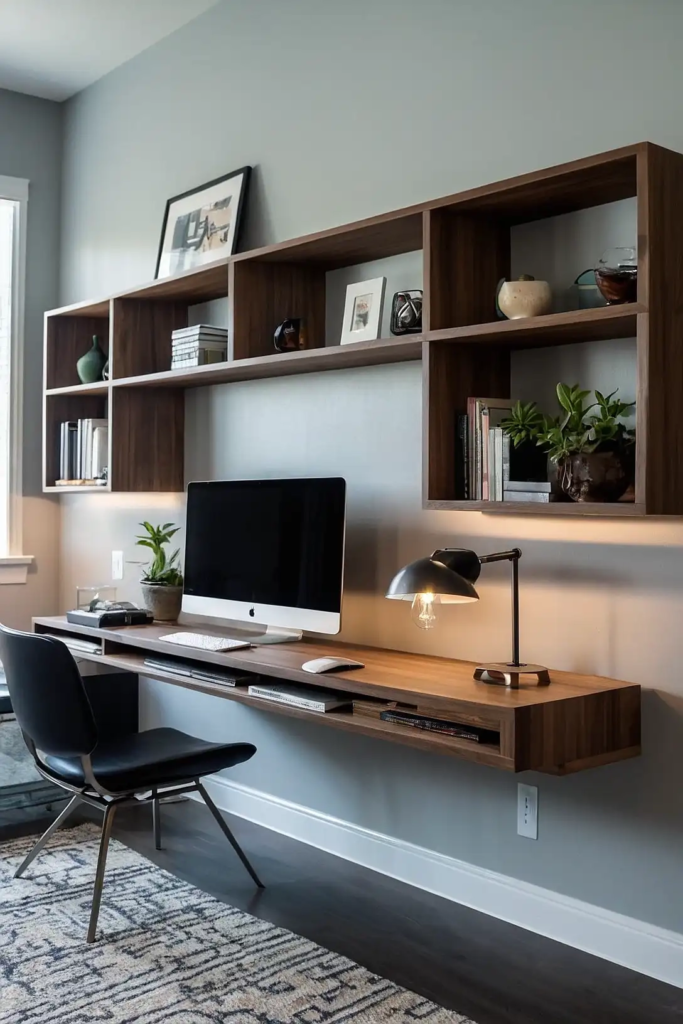
Install a wall-mounted shelf at desk height with additional floating shelves above for a minimal-footprint workspace.
This vertical arrangement preserves valuable floor space in compact living areas. The upper shelves serve both practical storage and decorative display purposes.
Choose shelving that matches other decorative elements in your living room for cohesive design.
This minimal approach works well for laptop-based tasks requiring limited physical workspace.
19: Sideboard with Pullout Surface

Repurpose a traditional living room sideboard by adding a pullout work surface at proper typing height.
This adaptation maintains the piece’s decorative function while adding productivity capabilities.
Use interior drawers and cabinets to organize office supplies out of sight. The substantial top surface provides space for decorative items that maintain your living room’s aesthetic.
When work is finished, simply slide the work surface away and close any opened storage components.
20: Window Seat Office Combination

Transform a window seat area into a functional workspace with a hinged top that reveals office storage.
This dual-purpose arrangement maximizes functionality in a typically underutilized space. The hidden storage compartment perfectly houses laptops, documents, and supplies.
Install a comfortable cushion that allows the area to serve as casual seating when not used for work.
Add electrical outlets nearby for convenient device charging without unsightly cords.
21: Flip-Top Ottoman Workstation

Incorporate an ottoman with a reversible top that transforms from soft surface to rigid work platform.
These ingenious pieces serve triple duty as seating, storage, and impromptu desks.
The interior compartment stores laptops, chargers, and office essentials out of sight. When flipped, the rigid surface provides stable support for devices and writing.
This ultra-flexible solution adapts to changing needs throughout your day with minimal effort.
22: Accent Wall Office Zone
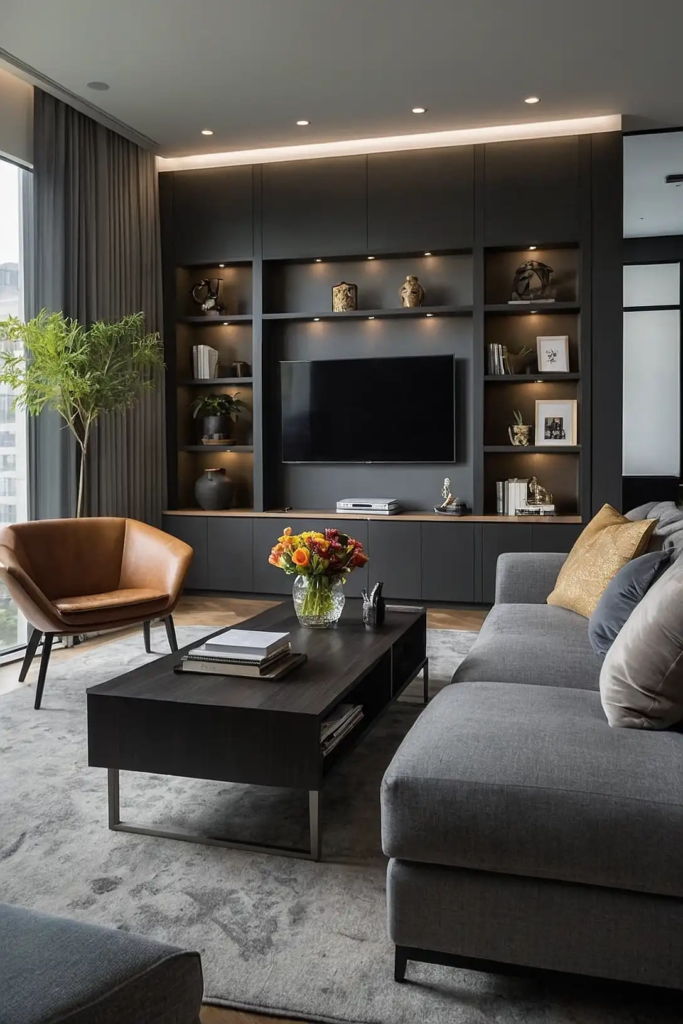
Designate one living room wall for office functions with contrasting paint or wallpaper that visually defines the area.
This simple boundary helps mentally separate work activities from relaxation. Install floating shelves and a wall-mounted desk within this designated zone.
The cohesive treatment creates an intentional-looking workspace rather than a temporary arrangement.
Carry some elements of the accent treatment into your living area for visual connection between zones.
23: Dual-Sided Sofa Table
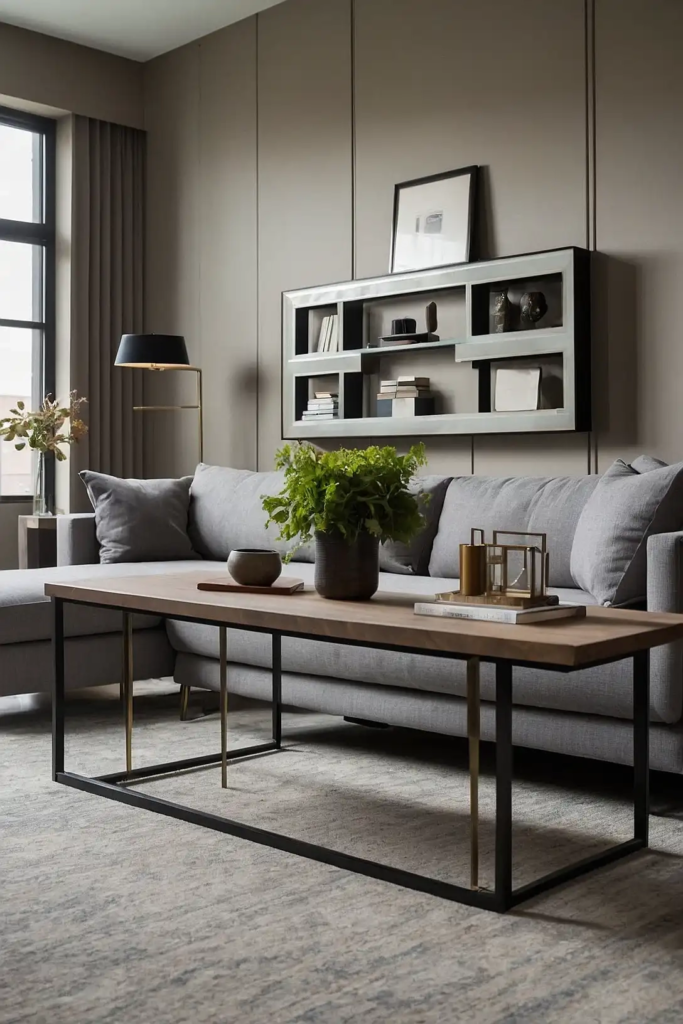
Utilize a console-height table behind your sofa that serves both as sofa table and desk. This boundary-creating piece clearly delineates living and working zones.
Add discreet power management solutions to handle technology needs without visible cords.
Select models with drawers facing both directions for access from either work or living sides.
Choose a design with finished backs and sides since all surfaces remain visible in this central placement.
24: Under-Stair Workspace

Transform the often-wasted area beneath stairs into a compact office nook adjacent to your living space.
This architectural feature naturally creates a semi-private work environment. The partially enclosed space helps minimize distractions during focused work sessions.
Add built-in shelving and lighting to maximize functionality within the unique dimensions.
This solution works particularly well in open-concept homes where dedicated rooms aren’t available.
25: Decorative Screen Divider
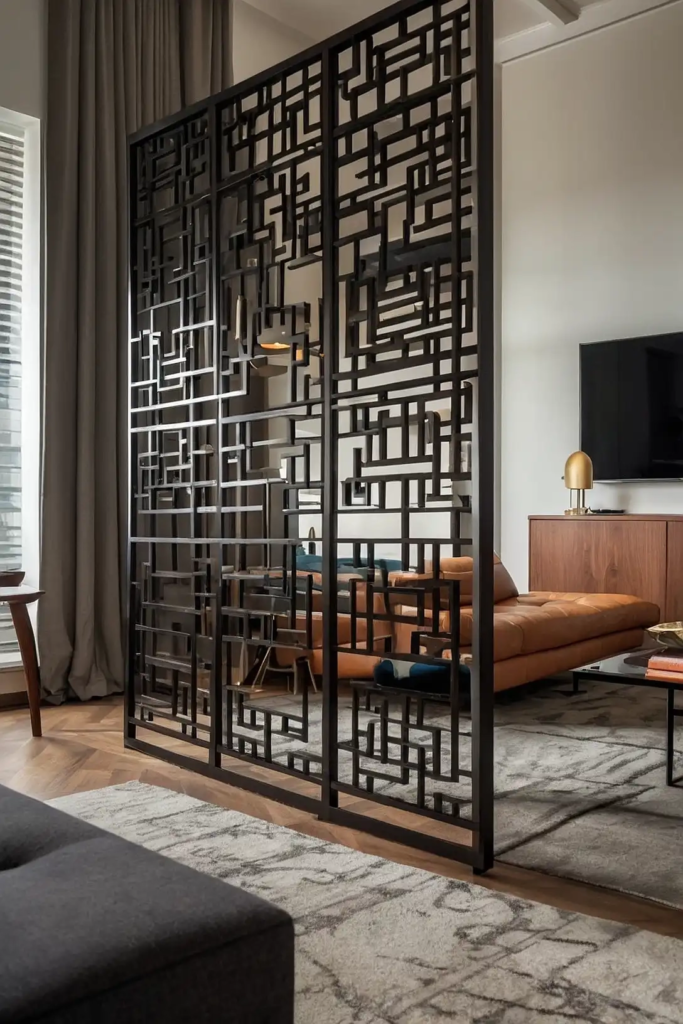
Use an attractive folding screen to create a temporary separation between office and living zones.
This flexible solution deploys when privacy is needed and stores compactly when not in use.
The movable nature allows for quick reconfiguration based on changing needs throughout your day.
Choose designs with decorative elements that contribute to your living room’s aesthetic. When privacy isn’t needed, partially fold the screen to serve as decorative wall art.
26: Credenza Workstation
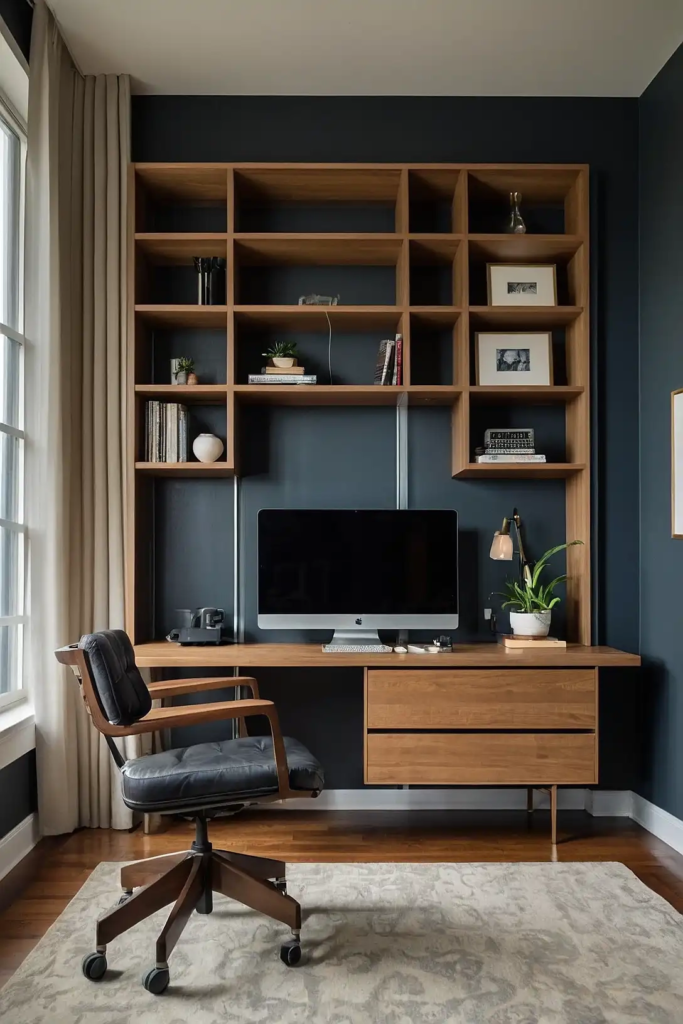
Adapt a stylish credenza to serve as both decorative living room furniture and functional workspace. These substantial pieces provide generous surface area and abundant storage.
Select models with keyboard trays or pullout work surfaces for ergonomic positioning. The extensive interior storage conceals office supplies, files, and technology when not in use.
Position lamps that serve both as decorative elements and task lighting for workspace illumination.
27: Gallery Wall Camouflage
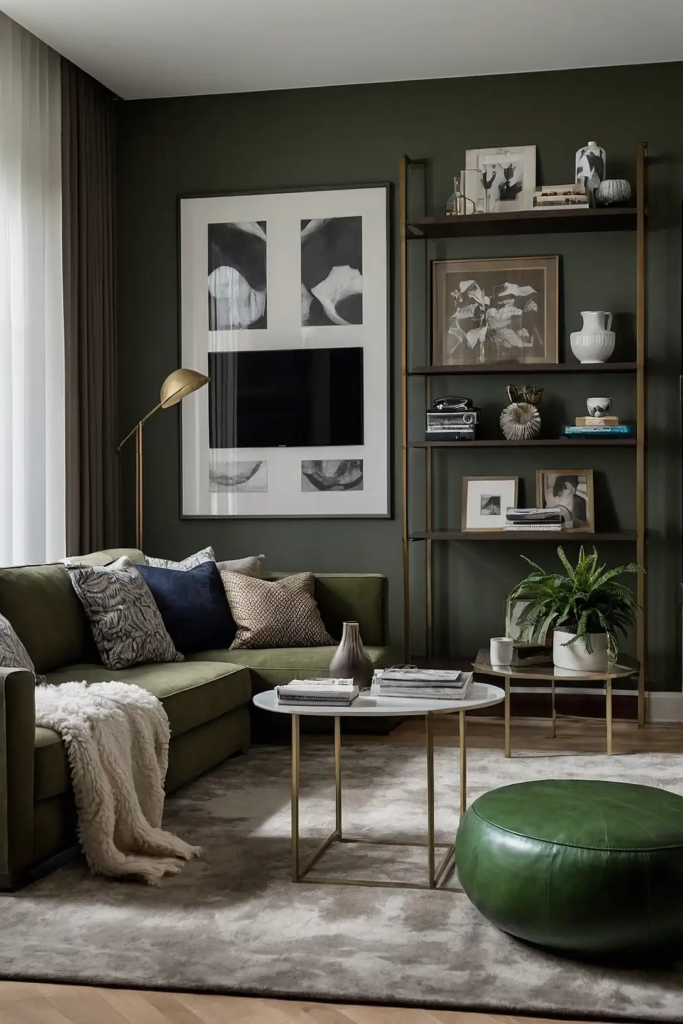
Integrate your workspace into a living room gallery wall, using the surrounding art to visually minimize the office elements.
The decorative arrangement draws attention away from utilitarian components. Choose office accessories in colors that complement your artwork for cohesive appearance.
Install a floating desk with minimal visual weight that reads more as a shelf than office furniture.
This disguise technique helps maintain your living room’s aesthetic while accommodating necessary productivity tools.
Conclusion
Implement these office-living room combination ideas by starting with your specific needs and space constraints.
Choose solutions that respect both functions equally, creating harmonious spaces that support your work and relaxation without compromising either.




